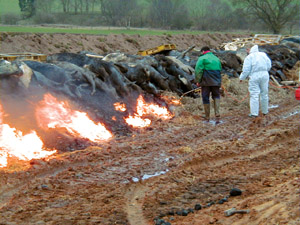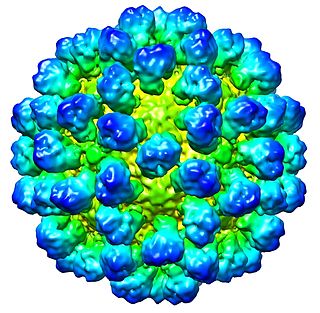Related Research Articles

Agricultural policy describes a set of laws relating to domestic agriculture and imports of foreign agricultural products. Governments usually implement agricultural policies with the goal of achieving a specific outcome in the domestic agricultural product markets.

Avian influenza, also known as avian flu, is a bird flu caused by the influenza A virus, which can infect people. It is similar to other types of animal flu in that it is caused by a virus strain that has adapted to a specific host. The type with the greatest risk is highly pathogenic avian influenza (HPAI).

The outbreak of foot-and-mouth disease in the United Kingdom in 2001 caused a crisis in British agriculture and tourism. This epizootic saw 2,000 cases of the disease in farms across most of the British countryside. Over 6 million cows and sheep were killed in an eventually successful attempt to halt the disease. Cumbria was the worst affected area of the country, with 893 cases.
The Pirbright Institute is a research institute in Surrey, England, dedicated to the study of infectious diseases of farm animals. It forms part of the UK government's Biotechnology and Biological Sciences Research Council (BBSRC). The institute employs scientists, vets, PhD students and operations staff.

Influenza A virus subtype H7N2 (A/H7N2) is a subtype of the species Influenza A virus. This subtype is one of several sometimes called bird flu virus. H7N2 is considered a low pathogenicity avian influenza (LPAI) virus. With this in mind, H5 & H7 influenza viruses can re-assort into the Highly Pathogenic variant if conditions are favorable.

Boehringer Ingelheim Animal Health is a multinational animal health company, formed in January 2017 when Merial was acquired by Boehringer Ingelheim and merged with Boehringer Ingelheim's existing animal health assets.

Rabbit hemorrhagic disease (RHD), also known as viral hemorrhagic disease (VHD), is a highly infectious and lethal form of viral hepatitis that affects European rabbits. Some viral strains also affect hares and cottontail rabbits. Mortality rates generally range from 70 to 100 percent. The disease is caused by strains of rabbit hemorrhagic disease virus (RHDV), a lagovirus in the family Caliciviridae.

The 2007 United Kingdom foot-and-mouth outbreak occurred when the discharge of infectious effluent from a laboratory in Surrey led to foot-and-mouth disease (FMD) infections at four nearby farms. The infections were detected via regular livestock testing by the Department for Environment, Food and Rural Affairs (Defra).
Deborah Reynolds CB served as the Chief Veterinary Officer (CVO) of the United Kingdom from March 2004 until she retired in November 2007. She is usually referred to as Debby Reynolds, or less often as Deborah Reynolds.

The Red Line, also referred to as the veterinary cordon fence, is a pest-exclusion fence separating northern Namibia from the central and southern regions. It encases several northern regions: Oshana Region, Kavango East Region, Omusati Region, Zambezi Region, Omaheke Region, Kunene Region, and parts of the Khomas and Oshikoto Regions. Most of these farms are fenced in and are accessible by constructed farm roads. North of the line, on the other hand, all farm land is communal and operated mostly by black farmers. Livestock is not constrained by fences and often ventures onto roads. The red line is a highly guarded line which has roadblocks to check every vehicle which passes. The red line is the reason for Namibia's unique status to export meat across the European Union.

Foot-and-mouth disease (FMD) or hoof-and-mouth disease (HMD) is an infectious and sometimes fatal viral disease that affects cloven-hoofed animals, including domestic and wild bovids. The virus causes a high fever lasting two to six days, followed by blisters inside the mouth and near the hoof that may rupture and cause lameness.
Vesicular exanthema of swine virus (VESV) is a virus which produces a disease in pigs that is clinically indistinguishable from the viruses causing foot-and-mouth disease (FMD) and swine vesicular disease (SVD). VESV affects only pigs and marine mammals. It is not transmissible to humans.

The Japan foot-and-mouth outbreak in 2010 occurred in Miyazaki Prefecture, affecting cattle, swine, sheep and goats. A similar outbreak had occurred ten years earlier, in 2000. Located on the eastern coast of Japan's Kyūshū island, Miyazaki Prefecture plays a significant role in supplying top-quality Wagyū cattle for the production of Wagyū beef throughout Japan including Matsuzaka and Ōmi. The number of livestock killed was 297,808, and the estimated economic loss was 235 billion yen.
A serious outbreak of foot-and-mouth disease occurred in South Korea in 2010–2011, leading to the culling of hundreds of thousands of pigs in an effort to contain it. The outbreak began in November 2010 in pig farms in Andong, Gyeongsangbuk-do, and has since spread in the country rapidly. More than 100 cases of foot-and-mouth disease have been confirmed in the country so far, and South Korean officials have started a mass cull of approximately 12 percent of the entire domestic pig population and 107,000 of three million cattle of the country to halt the outbreak.
John Burns Brooksby was a Scottish veterinarian, animal physiologist and veterinary virologist. He was a recognised expert on serology and especially foot-and-mouth disease, and identified and categorised the majority of its known forms. His advice was taken on an international level, and he played a significant role in disease control in Africa and the Middle East.
A Foreign animal disease (FAD) is an animal disease or pest, whether terrestrial or aquatic, not known to exist in the United States or its territories. When these diseases can significantly affect human health or animal production and when there is significant economic cost for disease control and eradication efforts, they are considered a threat to the United States. Another term gaining preference to be used is Transboundary Animal Disease (TAD), which is defined as those epidemic diseases which are highly contagious or transmissible and have the potential for very rapid spread, irrespective of national borders, causing serious socio-economic and possibly public health consequences. An Emerging Animal Disease "may be defined as any terrestrial animal, aquatic animal, or zoonotic disease not yet known or characterized, or any known or characterized terrestrial animal or aquatic animal disease in the United States or its territories that changes or mutates in pathogenicity, communicability, or zoonotic potential to become a threat to terrestrial animals, aquatic animals, or humans."
The Diseases of Animals Act is a series of acts of Parliament of the UK to deal with the possibility of the accrual of economic harm or intra-species contamination. It follows on from the 19th-century series notation Contagious Diseases (Animals) Act. The Act of 1884 was designed to combat "heavy losses" due to cattle diseases such as rinderpest, contagious bovine pleuropneumonia and foot-and-mouth disease (FMD). The series was consolidated by the Act of 1950. The Act of 1950 authorised the Ministry, when all other avenues of tuberculin prevention failed, to cull badgers, and to halt the transportation of cattle from herds prone to FMD. Apparently the definition of poultry needed to be extended in 1953, to include birds of the species psittaciformes, doves, peafowl and swans. The series was stopped and continued by the Animal Health Act 1981.

The United Kingdom was afflicted with an outbreak of Bovine spongiform encephalopathy, and its human equivalent variant Creutzfeldt–Jakob disease (vCJD), in the 1980s and 1990s. Over four million head of cattle were slaughtered in an effort to contain the outbreak, and 178 people died after contracting vCJD through eating infected beef. A political and public health crisis resulted, and British beef was banned from export to numerous countries around the world, with some bans remaining in place until as late as 2019.
Sir Percy John Luxton Kelland, known as Sir John Kelland, was the Chief Veterinary Officer in the Diseases of Animals Branch at the Ministry of Agriculture and Fisheries between 1932 and 1938.

The 2022 lumpy skin disease outbreak in India resulted in the death of over 97,000 cattle in three months between July and 23 September. Starting from outbreaks in Gujarat and Rajasthan, in three months cattle in 15 states across India were affected. On 21 September, out of 18,50,000 cases over 65% of cases were from Rajasthan. Over 50,000 deaths were reported from Rajasthan. India's cattle population according to the last livestock census was 192.5 million.
References
- 1 2 3 Brown, Paul (14 March 2001). "Crisis now worse than in 1967". Guardian Online . Retrieved 23 August 2009.
- 1 2 3 4 5 6 7 "FMD: Comparisons with the 1967 FMD outbreak". Department for Environment Food and Rural Affairs. 25 June 2008. Archived from the original on 2009-11-06. Retrieved 15 October 2009.
- ↑ "Foot and Mouth disease - FMD". EDEN. Archived from the original on 1 October 2009. Retrieved 24 August 2009.
- ↑ Bowden, Hilary (21 February 2001). "Nobody knew who would be next". British Broadcasting Corporation . Retrieved 15 October 2009.
- ↑ Henderson, FRS, Sir William. "Hugh Algernon Percy, 10th Duke of Northumberland". Royal Society.
- ↑ "1967: Remembering the epidemic". BBC News . British Broadcasting Corporation. 24 February 2001. Retrieved 23 August 2009.
- ↑ Mayor, Susan (5 May 2001). "UK investigates possible human cases of foot and mouth disease". Pub Med Central. BMJ . Retrieved 23 August 2009.